Circulation
Circulation patterns within the Southern California Bight (SCB), the coastal ocean from Point Conception to just south of San Diego and inshore of the Santa Rosa Ridge, are more complex than elsewhere off the west coast of the United States. The equatorward California Current (CC), a well-described eastern boundary current, dominates flow in this region, and is strongest during summer.
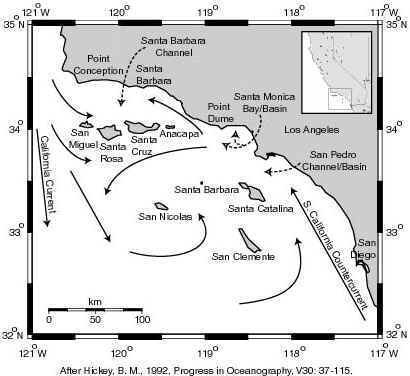
The CC branches shoreward and then poleward in the SCB, forming the Southern California Countercurrent (SCC), and, at times, an eddy-like cyclonic circulation (i.e. the Southern California Eddy) whose seasonal maximum is summer to early fall. The California Undercurrent, also strongest in summer, similarly exhibits poleward flow over the continental slope in this region.
The strongest equatorward winds are found during spring along most of the California coast. At this time, the CC moves closer to shore and accelerates, producing mainly equatorward flow in the SCB. Thus, poleward flow in the SCB experiences a minimum during spring when the CC impinges on the Bight, and a maximum in summer when the CC moves further offshore and spreads out, allowing more water to shear from the CC, promoting the flow of the SCC.
Winds in the SCB are generally weaker but highly variable as compared to the rest of the California coast. Related to this, upwelling events within the Bight tend to be limited to winter and early spring; local upwelling during summer, while strong elsewhere along the California coast, is minimal in the SCB due to a large reduction in wind stress. Temporally and spatially variable local winds, as well as eight nearshore islands and numerous coastal promontories, submarine canyons, basins, and ridges introduce complexity to these large-scale circulation patterns, particularly in the form of sub-mesoscale or small-scale eddies that are typically under 50 km in diameter. The following section will discuss these important yet under-sampled features in detail.
Identification of Eddies in the Southern California Bight
As mentioned in the discussion of regional circulation above, small-scale eddies (< 50 km diameter) are common features in the Southern California Bight (SCB), particularly in the Santa Barbara Channel and Santa Monica-San Pedro Basin regions. Eddies are more or less circular movements of water, somewhat similar to cyclonic storms in the atmosphere such as hurricanes and tornadoes. They can result from a variety of mechanisms, including current instabilities and topographic, tidal and wind forcing. The small-scale eddies found in the SCB have important implications for this complex coastal marine ecosystem, requiring detailed characterizations of their bio-geophysical properties. Unfortunately, their small size can make them difficult to identify and analyze, meaning there is much we do not know about their life histories. The following sections provide numerous examples of these SCB eddies, observed both remotely (e.g. satellites) and in situ (e.g. moorings and drifters). Our focus here is on the satellite measurements from two different types of sensors.
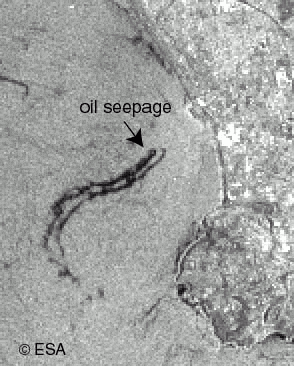
First, imaging radar data that depict sea-surface roughness are shown here. These data, also known as Synthetic Aperture Radar (SAR) imagery, are the principal means by which we observe and describe small-scale SCB eddies, for reasons to be discussed below.
In SAR imagery, brighter regions indicate rougher waters (e.g. due to higher wind speeds); darker regions indicate flatter, calmer waters (e.g. due to lower wind speeds and/or the presence of surfactants in the water, like natural oils). Differences in sea-surface roughness, quantified in terms of backscatter, can be used to identify oceanographic (e.g. eddies) and atmospheric (e.g. lee waves) features. SAR imagery is derived from data acquired by active microwave sensors found on both European Remote Sensing Satellites (ERS-1, ERS-2) starting in 1991 (ERS-1), as well as the Canadian Radar Satellite (RADARSAT) since 1995. The SAR image above is discussed on the Pollution page.
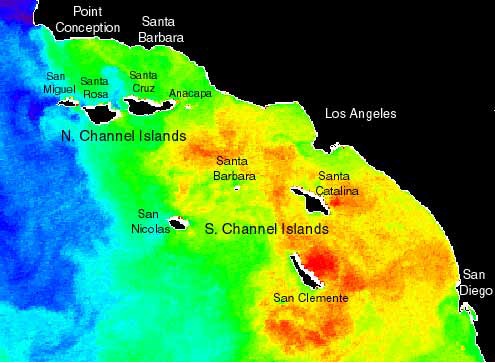
The second type of satellite imagery used to identify eddies is in the form of false-color Sea-Surface Temperature (SST) images. Here, warmer waters are depicted via yellow, orange, and red pixels and colder waters via blue and green pixels; land and clouds are generally indicated by white or black pixels. Differences in the observed temperature patterns can likewise be used for oceanographic feature detection and analysis. The SST imagery was derived from measurements made by Advanced Very High Resolution Radiometer (AVHRR) sensors found aboard NOAA polar-orbiting satellites since 1978.
Unlike AVHRR, SAR is capable of imaging a region regardless of cloud cover. Further, SAR imagery has significantly higher spatial resolution (~ 30 m) than that provided by AVHRR (~ 1 km), potentially allowing for much smaller oceanographic features to be detected. Thus, for purposes of identifying the small-scale SCB eddies, SAR imagery is a critical component. However, SAR imagery also has its limitations, particularly in that ocean features are generally only visible under moderate wind conditions (e.g. 2-8 m/s). More information regarding SAR and AVHRR sensors, and likewise their data and its interpretation, will be located in the Technology section of this website upon its completion.
Eddies in the Santa Barbara Channel
The following three figures revealed, via both satellite and field data, the presence of a recurring small-scale eddy in the Santa Barbara Channel on July 1, 1994.
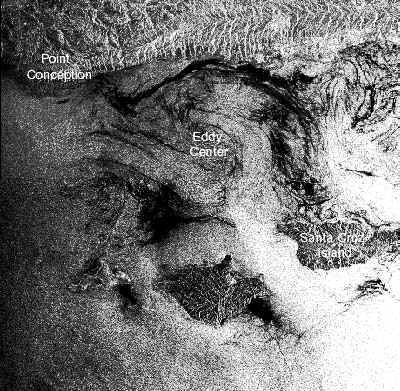
This is an ERS-1 SAR image. It shows an eddy that was approximately 35 km in diameter, visualized by distinct, narrow surface slicks, with a larger dark band to the north likely enhanced by the well-known natural oil seeps off Coal Oil Point to the west of Santa Barbara. Entrained in shear zones, this oil seepage helped improve the definition of the eddy flow pattern despite wind gusts in the area up to 8 m/s.
The eddy's flow appeared cyclonic (i.e. counter-clockwise rotation), with northwest flow emanating from the channel between Santa Cruz and Santa Rosa Islands towards the mainland, and southeastward return flow from the mainland in the western Santa Barbara Channel.
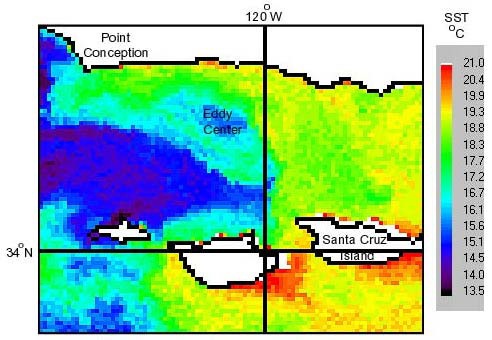
These patterns discussed above were supported by this coincident AVHRR SST image which showed warm water from the southeast extending north and then west along the coast. This warm water was split by southeast-flowing colder waters from north of Point Conception. Both water masses became mixed within the eddy.
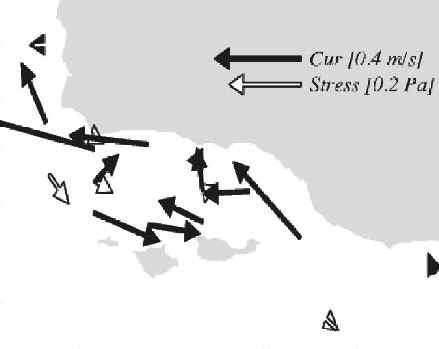
This diagram shows coincident ocean-current measurements from moorings (i.e. "Cur" in the figure) in the Santa Barbara Channel, corroborating the near-surface cyclonic flow demonstrated by the satellite data interpretations above. These mooring data, and those below, were kindly supplied by Clint Winant of the Scripps Institution of Oceanography, and were collected as part of the Santa Barbara Channel-Santa Maria Basin Circulation Study.
Note that the "Stress" arrows (white) represent wind flow.
Eddies in the Santa Monica-San Pedro Basin Region
Small-scale eddies are also extremely common features in the Santa Monica-San Pedro Basin regions, as illustrated by the next set of figures and the following series below.
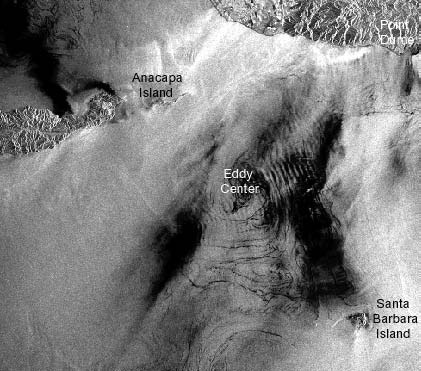
This is an SAR image of an apparently-recurrent small-scale eddy in the Santa Monica Basin region. This eddy, located between Anacapa and Santa Barbara Islands on November 29, 1994, appeared to be cyclonic, and was approximately 25 km in diameter.
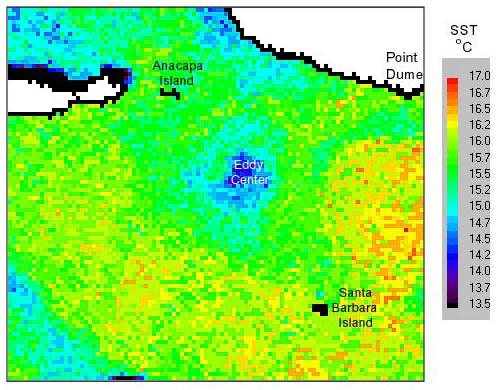
Coincident SST imagery to the SAR image above supported the likelihood of its counterclockwise rotation, and revealed a core temperature ~2° C cooler than surrounding waters.
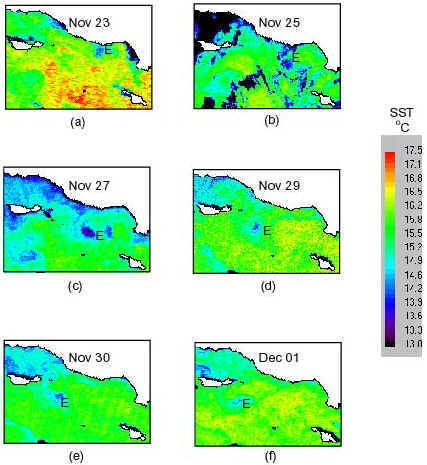
A sequence of SST images suggests that the above eddy (i.e. 'E' to the left) formed around November 23 and moved southwestward over a nine-day period at an approximate speed of 0.14 m/s. This eddy seemingly formed in association with an upwelling event off Point Dume at the northwest edge of Santa Monica Bay. Unfortunately, the eddy could not be tracked on AVHRR after December 1 due to persistent cloud cover.
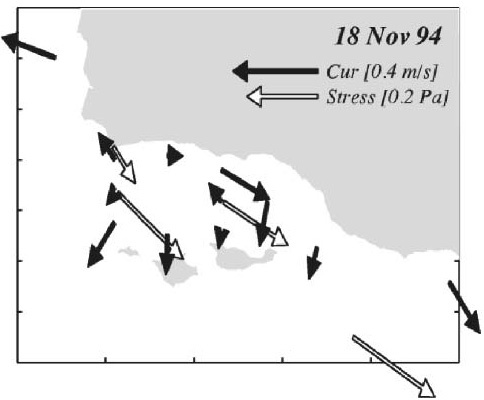
Mooring data indicated the presence of upwelling-favorable winds several days prior to this feature's first appearance on the AVHRR images. This eddy appears to be a recurring feature since eddies have been observed in this region in several other SAR images, but only during winter and early spring, when local wind-driven upwelling occurs in the Southern California Bight. Meteorological buoy records have indicated upwelling-favorable conditions prior to the appearance of each such feature observed in this area.
Note that wind flow is indicated by the white arrows, and the movement of the surface ocean is indicated by the black arrows.
Even smaller eddies are commonly found in the Santa Monica-San Pedro Basin regions, as observed in the following four SAR images.
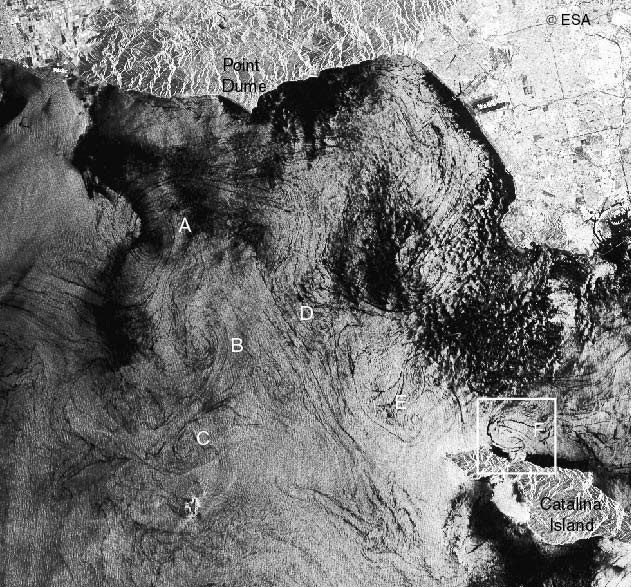
This is an SAR image that covered Santa Monica Bay and the Santa Monica and San Pedro Basins. It shows at least six eddies (see letters). Most of these eddies appeared to be cyclonic, with diameters less than 10 km. The eddy (F) surrounded by the box, is enlarged in the image below.
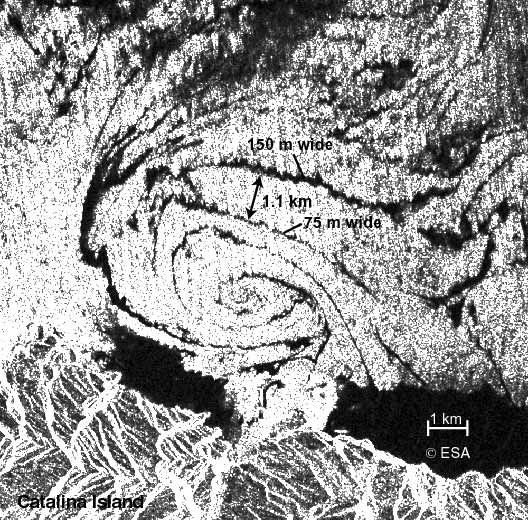
This is an enlarged view of the eddy (F) directly adjacent to Catalina Island from the image above. It was approximately 5 km in diameter, with its dark curvilinear bands readily visible by SAR. These bands (slicks) were approximately 50 to 250m wide and separated by roughly one kilometer near the outer edge of the eddy, narrowing to 150m at the core.
The narrow channel between Catalina and the mainland where this eddy was found, i.e. the San Pedro Channel, exhibits interesting circulatory properties that result in part from the constriction of flow that occurs there. Some evidence for this is provided by the last two SAR examples below.
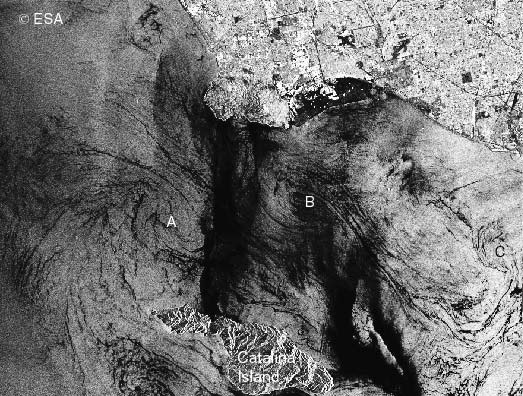
Here, SAR revealed two eddies that seemed to converge in the San Pedro Channel. The eddy towards the west, 'A', was apparently anticyclonic (i.e. clockwise rotation), the one towards the east, 'B', cyclonic. Another apparent eddy, 'C', was observed further to the east. These three eddies were all less than 15 kilometers in diameter.
The paired images below are from a one-day repeat sequence from the ERS-1/ERS-2 tandem mission.
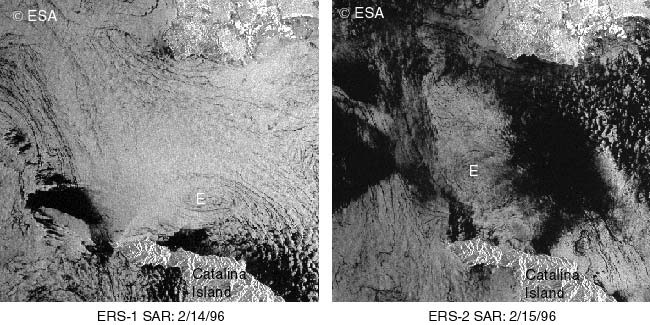
An apparent cyclonic eddy approximately 15 km in diameter is shown above, moving in a west-northwest direction at an average speed of 0.12 m/s. Unlike AVHRR, this represented the only instance where we were able to observe an individual eddy in SAR for more than one day; the poor temporal coverage afforded by ERS-1 and ERS-2 SAR individually (35 day repeat cycle) made this an unlikely occurrence. However, this short time-series demonstrated that we are in fact able to observe spatially coherent, persistent oceanographic features via SAR imagery.
Discussion of SCB Small-Scale Eddy Characteristics and Implications
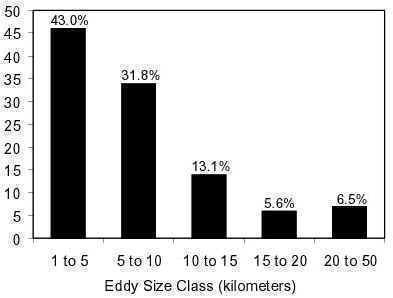
From an archive of SAR images, more than 100 small-scale eddies in the Southern California Bight (SCB) have been identified. Most (75%) of these SCB eddies were under 10 km in diameter as is shown by the figure to the left. Regarding their rotation, these small-scale eddies were overwhelmingly (94%) cyclonic (i.e. counterclockwise). Likely explanations for this predominance of cyclonic rotation are discussed in Munk et al. [2000]. The eddies appeared to be generally short-lived, on the order of days to weeks at most.
As seen in the table below, fall and winter together exhibited roughly twice as much small-scale eddy activity in the SCB than did the corresponding spring and summer period. Though this observed seasonality could be an artifact related to generally higher spring and summer SCB winds that might mask features on SAR imagery (i.e. 'wind aliasing'), instantaneous wind data associated with SAR frames used in this study (see table) do not clearly support this assertion.
| Measurement | Winter (Dec-Feb) |
Spring (March-May) |
Summer (June-Aug) |
Fall (Sept-Nov) |
|---|---|---|---|---|
| Average number of eddies per standardized SAR frame | 2.1 | 0.7 | 1.1 | 1.6 |
| Mean wind speed (m/s) for SAR frames with eddies | 2.65 | 2.97 | 3.02 | 2.44 |
| Mean wind speed (m/s) for SAR frames without eddies | 5.33 | 5.02 | 3.16 | 4.51 |
| Mean wind speed (m/s) for all SAR frames (both with and without eddies) | 4.11 | 4.42 | 3.22 | 3.61 |
We do see some effect of wind speeds on eddy detection in SAR imagery, however. As seen in the table above, mean wind speeds are uniformly higher for SAR frames without eddies than SAR frames with eddies.
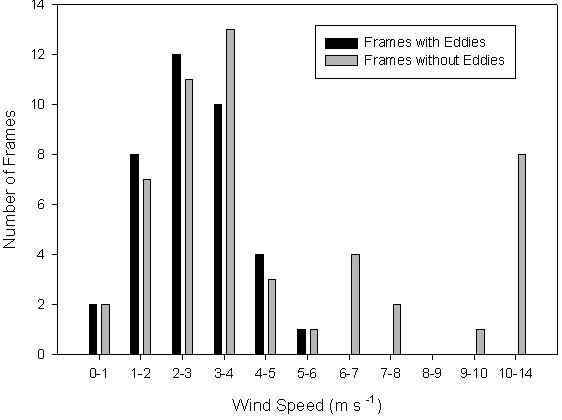
The figure above shows that eddy observations are generally high at low to moderate wind speeds, but taper off with winds between 4-6 m/s. At wind speeds higher than 6 m/s, none of the SAR frames contain eddies. This is probably due to the large waves that form due to high-velocity winds, with the large waves causing scattering of the radar signal from the satellite above, reducing the return signal to the satellite.
Conversely, low to moderate wind speeds alone do not ensure the presence/detection of eddies, for below 6 m/s, frames are equally divided between those that contain eddies and those that do not. Further, there is little difference in mean wind speed between summer SAR frames with eddies and without them (see table above). Based on these patterns, it seems apparent that some non wind-related eddy distribution patterns (seasonal and otherwise) are discernable in our results, as highlighted in the next figure.
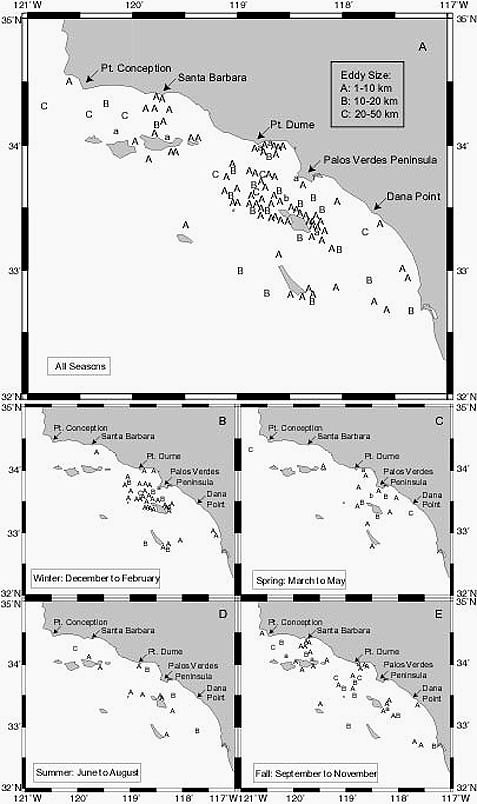
The spatial and temporal distributions of these small-scale SCB eddies are illustrated in this figure. The eddies appeared to result from a number of forcing mechanisms. Around obstacles to flow (e.g. islands and headlands), there were clusters of eddies less than 10 km in diameter, suggestive of topographic influence and possible recurrence in time and/or space. Numerous eddies were found in the Santa Monica Basin away from such topographic features, potentially indicative of their local generation (e.g. shear instabilities, see Munk et al.2000), if not advection from source regions elsewhere (e.g. Hickey, 1993). Eddies were also abundant in the Santa Barbara and San Pedro Channels, regions of constricted and /or converging flow. The eddy-deficient region offshore was the result of fewer SAR image retrievals for these waters, but even when such images were examined few eddies were observed, probably due to the stronger winds characteristic of that region.
To a considerable extent, the general seasonal distribution patterns of these eddies likely reflect the large-scale wind and current regimes discussed above in the introduction. Seasonal variability in the SCB is discussed in further detail by Winant and Dorman [1997], Hickey [1998], Bray et al. [1999], and Winant et al. [1999] among others, and in relation to small-scale eddies by Harms and Winant [1998] and DiGiacomo and Holt [2000]. Further research is currently underway in an attempt to improve our understanding of the life-history characteristics of these eddies, particularly their genesis, distribution, persistence, and seasonality. Investigating the SCB eddies is critical as they likely affect numerous coastal zone phenomena, including nutrient concentrations, plankton patchiness, productivity, larval transport and recruitment, and dispersal of pollutants. Satellite observations of these eddies' impact on phytoplankton distributions and natural oil seepage will be presented in the Biology and the Pollution sections.





